The all-electric Chevy Bolt is a Tesla Model 3 competitor
Is it really that good?

Sooooo ... the verdict?
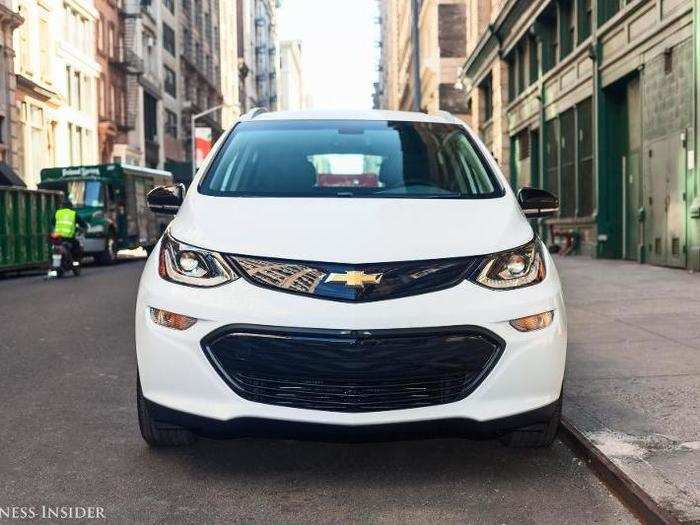
We were impressed with the Bolt, as a car, as an electric car, and as a mobility concept. In many ways, it is GM's post-bankruptcy masterpiece, a real feather in the cap of CEO Mary Barra and her executive team, who took what the company had achieved with its ill-fated EV-1 back in the 1990s and turned it up to 11.
I also flat-out loved driving it. I blasted in and out of New York City twice, rocketed around the streets of Gotham, darting through traffic, and cruised along the highways of New Jersey. I also enjoyed just driving it around the quiet streets of the suburb where I live.
The steering is quick and responsive, and the handling is sharp enough to provide the confidence you need when surfing that sweet EV torque.
The single-pedal mode is also very cool — I dug not using the brakes at all for extended excursions in my town. After a bit of practice, you get into a kind of Zen state with it.
Not a soul asked me about the car, and that can be chalked up to the ho-hum design. But I didn't care. I was lovin' it. Plain and simple, the Bolt is fun. And it emits not one ounce of tailpipe greenhouse gas. Chevy says it will save you $4,250 on gas over five years, while costing $550 per year to keep charged.
That comes out to approximately $45 per month in electricity, but if you aren't using the Bolt for daily commuting, you could spend less than that. In fact, that's where I think some real game-changing potential comes into play. A few years back, I looked at leasing a Honda FitEV, which had about 80 miles of battery range. But it just wasn't enough. With the Bolt's 200-plus miles, you can forget about constantly finding electricity and relax. This will encourage far more people to check out the vehicle.
GM has outfitted the Bolt with a host of driver-assist-and-safety features, including a lane-keeping assist, a forward-collision alert, a blind-spot alert, and a cross-traffic alert. You're surrounded by airbags, and the Bolt's stability control makes for a secure ride. It gives up nothing on this front. And if anything does go wrong, you have OnStar to summon backup.
I didn't look at them at all, and I knew from experience with my Prius, which also does this kind of thing, that I wouldn't. But anyone who gets into the nuts and bolts — er, the electrons and inverters — of EVs will enjoy these visuals, which are quite well done and certainly pretty to look at.

If you love your PowerPoints and your fitness monitors, you'll dig these functions.
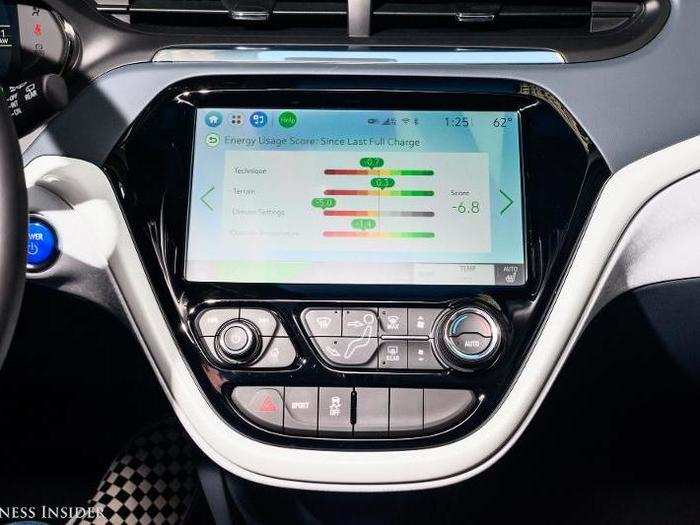
Cool EV stuff! the Bolt has several screens that provide information and data readouts regarding charging, power consumption, and so on.
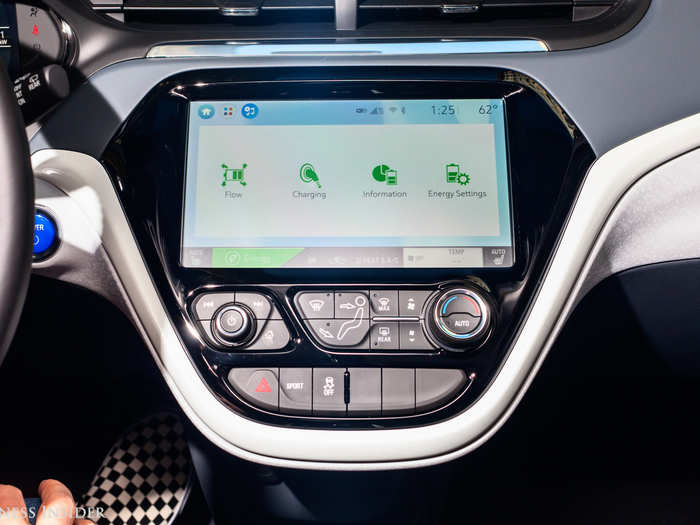
Here you can see the backing camera and the bird's-eye view — the camera isn't great, but it works fine. The Bolt also has, in Premier trim, a rearview mirror camera.
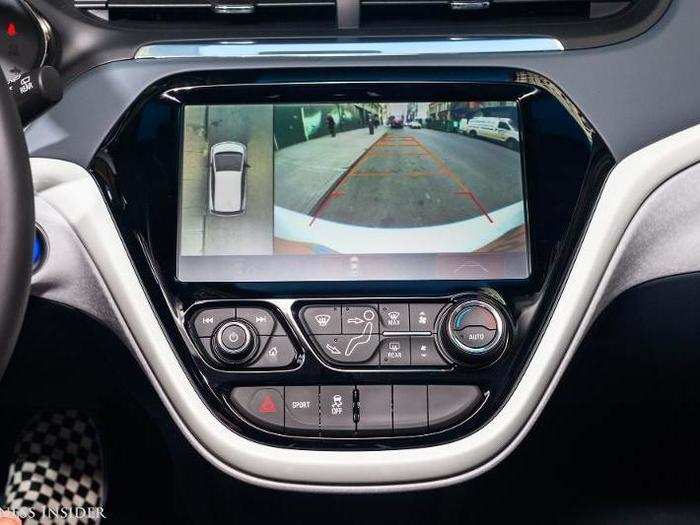
There's a suite of native apps to control music (the Bolt comes with a Sirius XM subscription), phone and Bluetooth pairing, OnStar, image uploading and storage, and assorted vehicle settings.
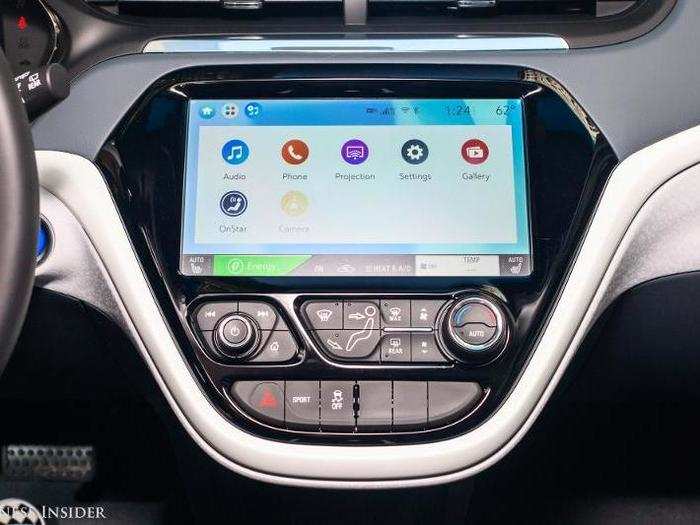
Bluetooth pairing was a snap, and Apple CarPlay in the Bolt is a beautiful thing, liberating Siri and turning her into the best voice-recognition system in the car business. There are AUX/USB ports (you can get two for the back seat as an option) as well as 12V charging.
A six-speaker Bose audio system is an option and sounds pretty good, especially given how quiet the Bolt is.
Just a quick thought on the HVAC system: although the heated steering wheel and heated seats fire up quickly, the actual heater takes a while to get going (no internal-combustion engine, less ambient heat). Obviously, we didn't try the AC, as it was winter in our region. But these systems are notorious battery drainers in EVs.
There is no native GPS navigation system! Instead, you use Apple CarPlay or Android Auto via a USB connection. You can also stay connected with the OnStar 4G LTE wifi so that you don't use up all of your wireless data.
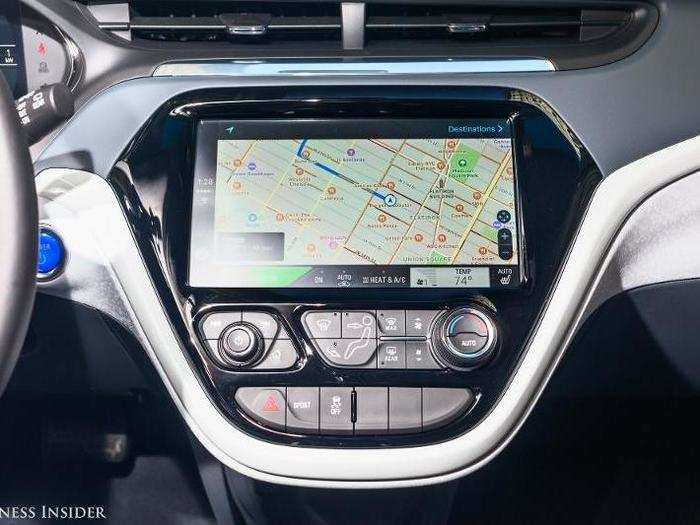
Apple CarPlay and Android Auto are available.
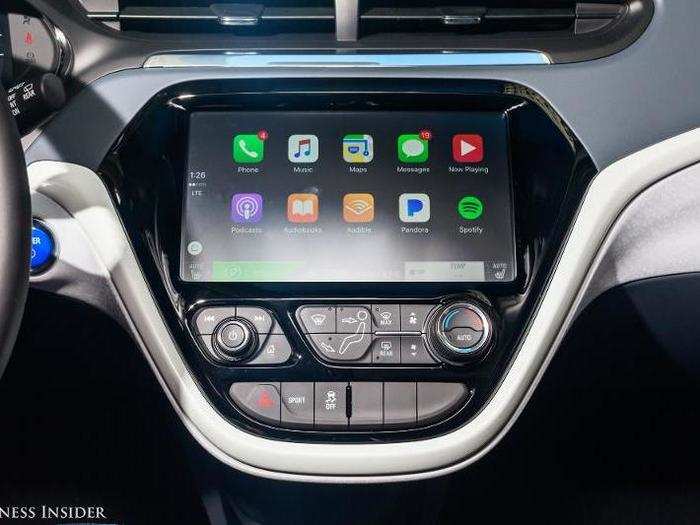
Let's review the MyLink infotainment setup. It all runs on a 10.2-inch central touchscreen and the interface is made up of tiles that give it a smartphone-like feel.
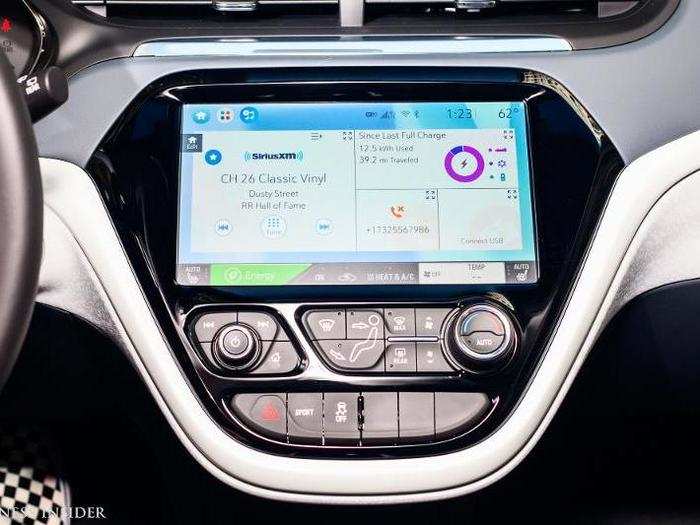
Also, very quiet, for a vehicle this size. It's sort of like getting in Dr. Who's TARDIS.

Because there's no engine, gas tank, or conventional drivetrain, the Bolt's interior, front and back, is quite roomy.
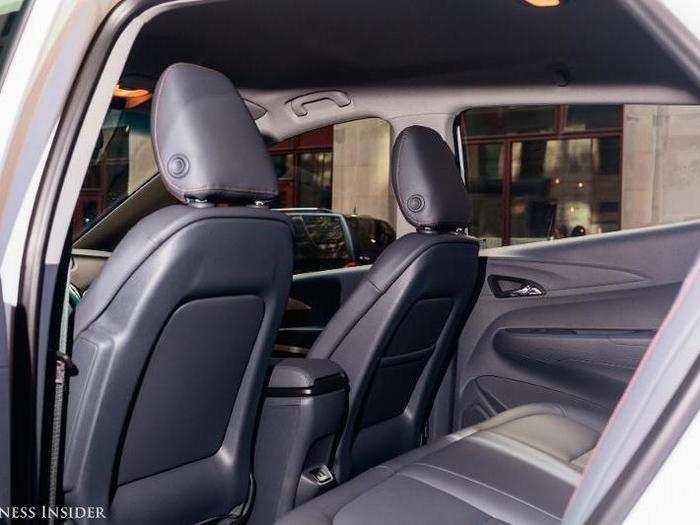
Now for the worst part — and perhaps the best?
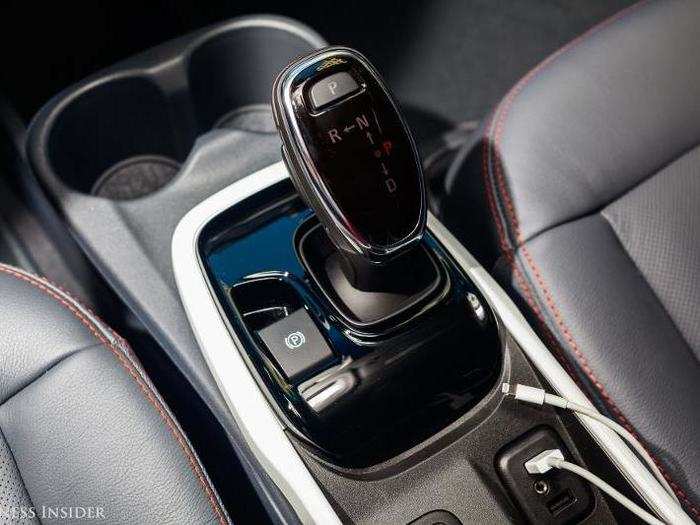
The Bolt uses GM's state-of-the-art and completely awful electronic toggle-y, joystick-y shifter. I'm accustomed to it from other GM vehicles, but I really hate it. (It is safe, however — you can't accidentally leave the car in neutral or shift to the wrong gear.)
If you use the "L" option, one toggle below Drive, you're in one-pedal regeneration mode and can pour power back into the battery seemingly out of thin air.
The Bolt has one gear, can access all 266 pound-feet of its torque at exactly one RPM of motor speed, and when you step on the "gas" — well, it doesn't have the same pickup as a Tesla in Ludicrous mode, but it is plenty quick.
Behind the heated leather-wrapped steering wheel (a nice extra on a car at this price point) is the really rather simple, all-digital instrument panel. It provides basic information, is customizable, and delivers the all-important range calculation on the left.
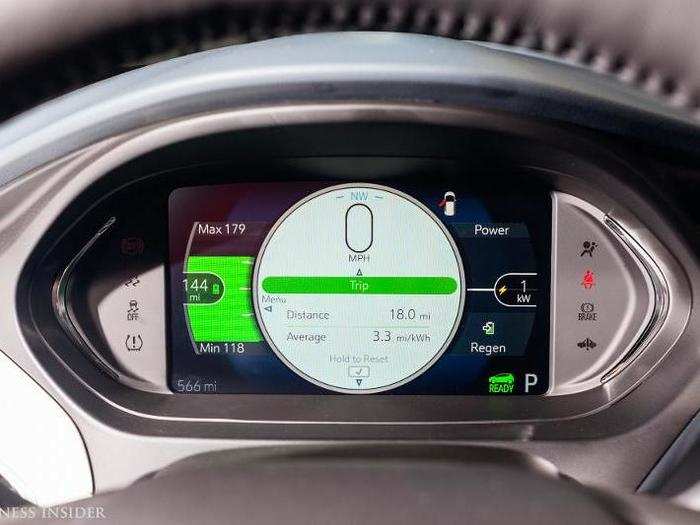
Range is determined by an algorithm that figures how much charge remains in the battery and then correlates it with your driving style and how much burden is being placed on the drivetrain. For example, because the Bolt uses regenerative braking, tooling around town gives you an estimated 128 MPGe, as braking helps to recharge the battery. But if you zooming along the highway, that drops to 110.
EVs are the opposite of gas-powered cars, which are more efficient as higher speeds. In the Bolt, you suck power at a faster rate on the freeway, and because you aren't braking, you get nothing back.
The Bolt's electronic brain calculates a range within the range: a minimum, a maximum, and what you can expect. If you put the car in Sport Mode, the range will decline. If you use one-pedal operation, relying on engine braking and a brake paddle behind the steering wheel except with you absolutely have to stop (it's easier than it sounds), you can see your range increase.
Our tester's interior was "Dark Galvanized Gray," two-tone, which reminded me more than a little of the new Toyota Prius I tested a while back. GM vehicles at this level used to have a parts-bin vibe to them, but the Bolt's interior felt more premium.
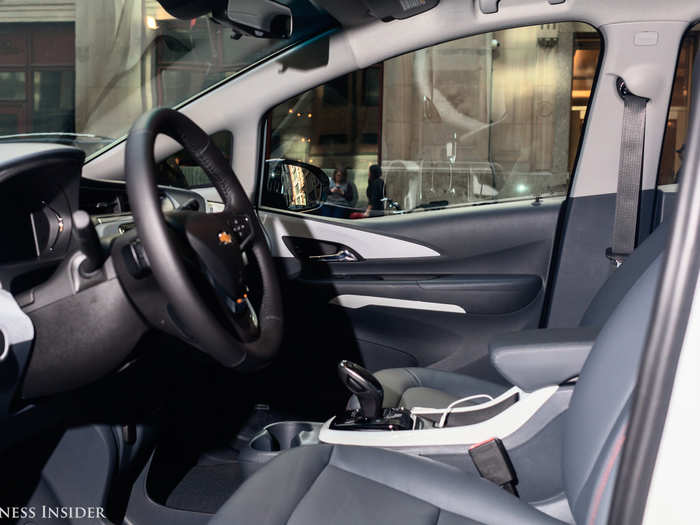
Let's talk charging.
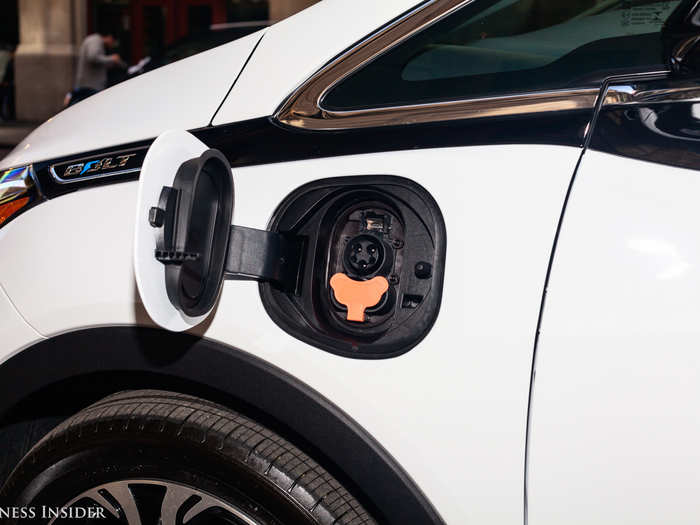
Beyond Level 1 at 120/220 volts, you have Level 2 and Level 3. Level 2 is widely served up by third-party providers such as ChargePoint. You sign up for the service and link a payment method. GM will also assist you in installing a 240-volt/32-amp charging station at your home, through a partnership with Aerovironment.
Level 2 charging gets you about 25 miles of charge per hour, so you can get back to fully juiced overnight. This was the variety of charging that we used, plugging the Bolt into a Level 2 ChargePoint station near my house. This worked well, but we had to leave the Bolt parked for long stretches, so many potential owners will want to explore the home setup.
Level 3 is DC fast charging, serving up about 90 miles of charge per 30 minutes of being plugged in. Tesla owners are familiar with this level because they can use the company's Supercharger network for longer journeys. Right now, widespread Level 3 charging is a missing link for the Bolt — and other long-range EVs. The expectation is that consumer demand will encourage more Level 3 stations to be brought online.
GM and other automakers are betting that electric vehicles with 200 plus miles of range will help ease consumers' concerns about "range anxiety."
We only had a brief period of fear while testing the Bolt. BI's Ben Zhang had to figure out if he had enough charge to make a 150-mile round trip. The Bolt had a little less than 200 miles in the tank at that point, but he covered the distance with about 30 miles to spare.
Chevy provides a smartphone app that lets owners monitor the Bolt's charge levels. The car can also be configured for location-based charging, using its GPS, so that you can schedule recharging at off-peak hours at home.
The business end of the Bolt is located where the engine would be in a gas-powered car, while the battery runs along the floor. there's no "frunk," as there is on a Tesla Model S. The Bolt has one electric motor, which is located over the front wheels.
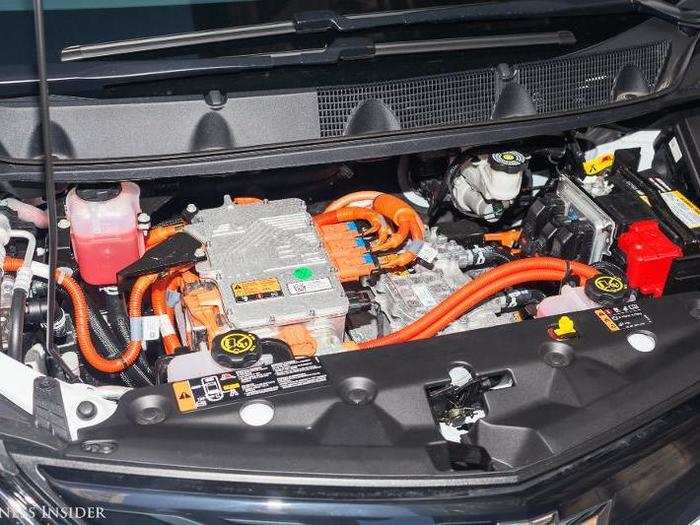
But it's built with pride at GM's Orion Assembly plant in Detroit!

The Bolt badging is subdued, and the exterior — constrained overall by the aerodynamic requirements of EVs — mixes in some black contrasts and a bit of chrome. I'd call it minimalist rather than stylish. A Ferrari it isn't.
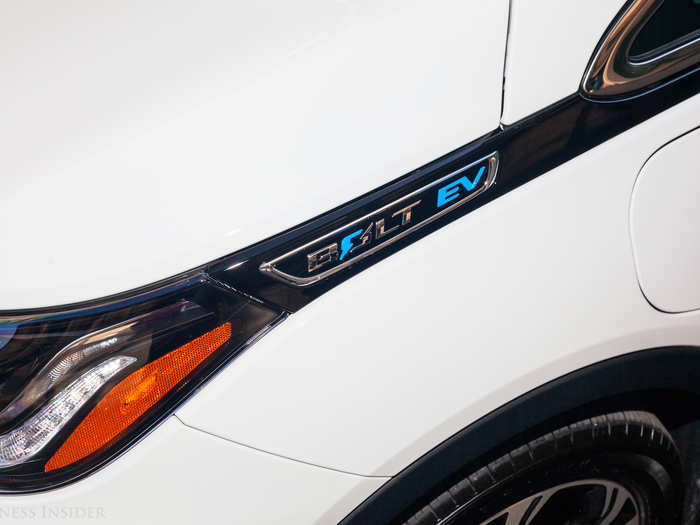
OK, so let's be perfectly honest. Although the Bolt looks sort of iPhone techno-groovy in white, the design isn't exactly Tesla-esque. It doesn't stand out, but it does get the job done. Frankly, it's more Prius than anything else. Which could be a good thing.
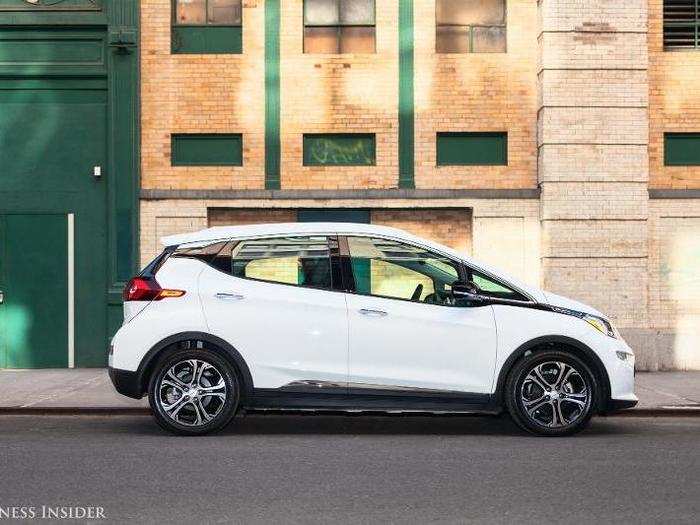
You'll also find the 120-volt charging cable back here, neatly stowed away.
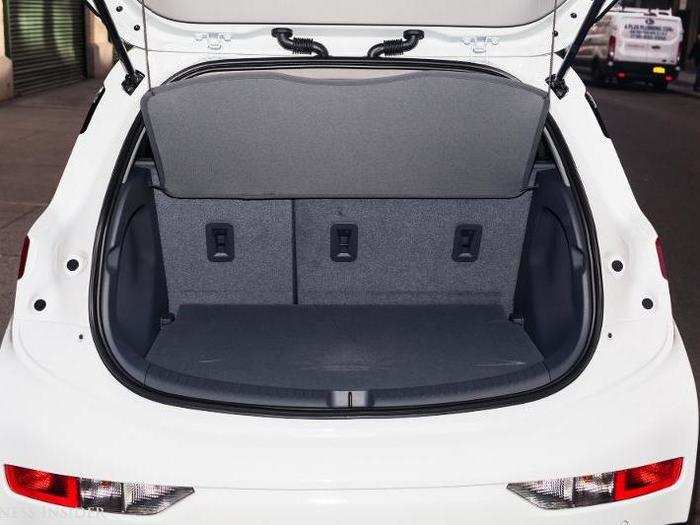
The back cable will enable you to plug into "Level 1" charging, which is a wall outlet. GM tells me it could take more than 24 hours to fully recharge the battery this way, but it would be useful for topping off the charge.
The Bolt will always default to 120 amperages when charging in this mode, but if you plug into 220-volt appliance power, you can override the default and charge a bit faster.
The hatch can swallow a decent amount of cargo, enough for a weekend jaunt and is more than adequate for suburban grocery shopping duty. A family of four will stretch the Bolt's capabilities, and a family of five will probably need a bigger set of wheels. However, GM has said the next addition to the Bolt lineup will be larger.

The Bolt was envisioned by the carmaker's Korean studio, a lab for the company's small-car platforms. Because it was engineered around its large, 60 kWh LG battery pack — which provides actual structural integrity to the car — the Bolt is distinctive within GM's global lineup. That said, it does have that compact-crossover-hatchback look.

Our Bolt was "Summit White" and sported the familiar Chevy bow-tie badge.
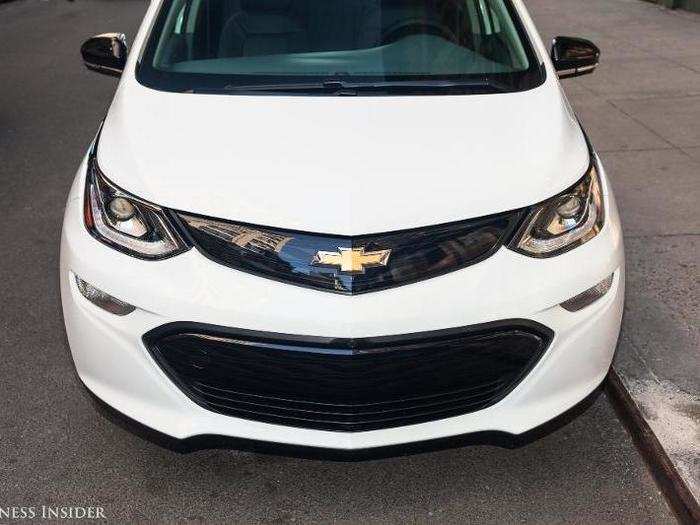
The base Bolt is $37,495, which means that a $7,500 federal tax credit drops the price to just under $30,000. Our tester was the Premier trim, which starts at $40,905. Once some options were added, we were looking at about $43,000.
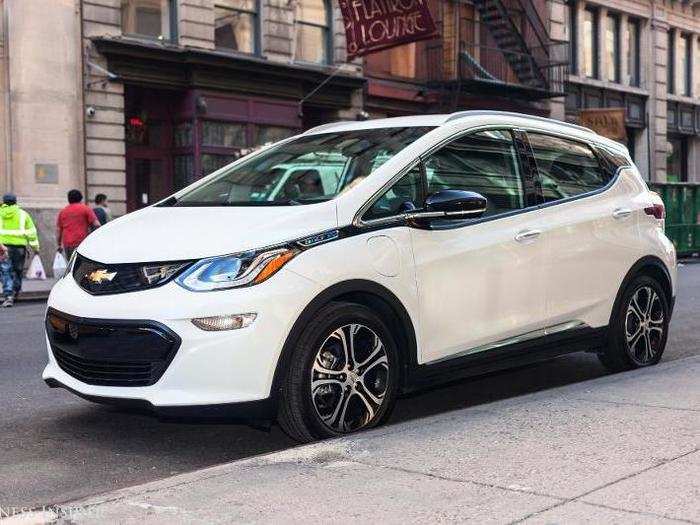
Popular Right Now
Popular Keywords
- India’s wearables market decline
- Vivo V40 Pro vs OnePlus 12R
- Nothing Phone (2a) Plus vs OnePlus Nord 4
- Upcoming smartphones launching in August
- Nothing Phone (2a) review
- Current Location in Google
- Hide Whatsapp Messages
- Phone is hacked or not
- Whatsapp Deleted Messages
- Download photos from Whatsapp
- Instagram Messages
- How to lock facebook profile
- Android 14
- Unfollowed on Instagram
Advertisement